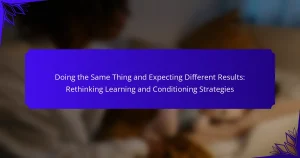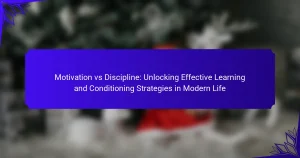Low expectations hinder student motivation and engagement, leading to poor learning outcomes. This article explores effective conditioning techniques that foster a growth mindset, enhance self-efficacy, and improve academic performance. It highlights the importance of positive reinforcement, goal setting, and consistent feedback in creating a supportive learning environment. Additionally, it addresses the adaptability of these techniques to meet diverse learning needs and the significance of emotional resonance in education.

How Do Low Expectations Impact Learning Outcomes?
Low expectations negatively impact learning outcomes by limiting students’ motivation and engagement. Research shows that when educators hold low expectations, students often internalize these beliefs, resulting in decreased performance and achievement. Effective conditioning techniques can counteract this by fostering a growth mindset, encouraging resilience, and enhancing self-efficacy. For instance, providing positive reinforcement and setting achievable goals can significantly improve students’ academic results.
What Psychological Theories Support the Concept of Low Expectations?
Low expectations can be supported by psychological theories such as the Expectancy Theory and the Self-Efficacy Theory. Expectancy Theory posits that individuals are motivated by the expected outcomes of their actions, suggesting that low expectations can lead to diminished effort and performance. Self-Efficacy Theory emphasizes the belief in one’s capabilities; low expectations can undermine this belief, leading to a cycle of underachievement. Both theories highlight how conditioning techniques can transform learning outcomes by adjusting expectations to foster greater engagement and success.
How Can Low Expectations Affect Student Motivation?
Low expectations can significantly diminish student motivation by fostering a belief that effort is futile. When educators set low expectations, students may disengage, believing they cannot achieve success. This mindset can lead to lower academic performance and reduced participation in class activities. Research indicates that high expectations from teachers correlate with increased student motivation and achievement. Fostering a positive learning environment with high expectations encourages students to strive for their best, enhancing overall educational outcomes.
What Role Does Self-Efficacy Play?
Self-efficacy significantly enhances learning outcomes by fostering motivation and resilience. Individuals with high self-efficacy are more likely to engage in challenging tasks and persist despite difficulties. Effective conditioning techniques, such as positive reinforcement and goal-setting, can elevate self-efficacy. Research indicates that students with strong self-efficacy beliefs achieve higher academic performance, demonstrating the critical role of self-efficacy in transforming learning experiences.
How Do Low Expectations Influence Classroom Dynamics?
Low expectations negatively impact classroom dynamics by fostering disengagement and limiting student potential. When educators maintain low expectations, students may internalize these beliefs, leading to decreased motivation and performance. Research shows that high expectations correlate with improved student outcomes, as they encourage a growth mindset and resilience. Consequently, effective conditioning techniques that raise expectations can transform learning environments, promoting higher achievement and better classroom interactions.

What Effective Conditioning Techniques Can Transform Learning Outcomes?
Effective conditioning techniques can significantly enhance learning outcomes by fostering a positive mindset and increasing motivation. Techniques such as positive reinforcement, goal setting, and consistent feedback create an environment conducive to learning. For instance, positive reinforcement encourages students to engage more actively, leading to improved retention of information. Setting clear, achievable goals helps learners track their progress, while regular feedback provides necessary guidance and adjustment opportunities. These strategies collectively transform low expectations into high achievements, ultimately enhancing educational experiences.
Which Conditioning Techniques Are Most Commonly Used?
Common conditioning techniques include positive reinforcement, negative reinforcement, classical conditioning, and operant conditioning. These methods enhance learning outcomes by shaping behavior and responses effectively. Positive reinforcement encourages desired behaviors through rewards, while negative reinforcement removes unpleasant stimuli to promote learning. Classical conditioning associates a neutral stimulus with a meaningful one, creating learned responses. Operant conditioning modifies behavior through rewards and punishments, influencing future actions. Each technique plays a crucial role in transforming learning experiences in today’s educational landscape.
What Is Operant Conditioning and How Does It Work?
Operant conditioning is a learning process that uses rewards and punishments to shape behavior. It transforms learning outcomes by reinforcing desired behaviors, which can significantly enhance educational effectiveness. This technique is particularly relevant in today’s world, where adaptive learning strategies are essential for engagement. Studies show that consistent reinforcement can lead to improved retention rates, making it a unique attribute of modern educational approaches. As a result, educators are increasingly integrating operant conditioning techniques to foster better learning environments.
How Can Classical Conditioning Be Applied in Education?
Classical conditioning can enhance education by creating positive associations with learning experiences. Teachers can use techniques like reward systems to reinforce desired behaviors and improve student engagement.
For instance, pairing praise with successful task completion encourages students to repeat those behaviors. This method can transform low expectations into higher learning outcomes by fostering a supportive environment.
Additionally, consistent application of conditioning techniques can lead to lasting behavioral changes, as students begin to associate learning with positive emotions. As a result, effective conditioning can significantly improve educational experiences in today’s classrooms.
What Are the Unique Benefits of Positive Reinforcement?
Positive reinforcement enhances learning by fostering motivation, improving retention, and promoting positive behavior. This technique encourages desired actions through rewards, leading to better educational outcomes. Research indicates that students exposed to positive reinforcement show increased engagement and achievement. This approach cultivates a supportive learning environment, ultimately transforming low expectations into high performance.

What Are the Universal Attributes of Effective Conditioning in Learning?
Effective conditioning techniques in learning focus on fostering high expectations to improve outcomes. Core attributes include reinforcement, feedback, adaptability, and engagement. Reinforcement shapes behavior through positive outcomes, while feedback guides learners towards improvement. Adaptability allows techniques to meet diverse learning needs, and engagement sustains motivation. These attributes collectively enhance learning effectiveness in today’s educational landscape.
How Does Consistency in Reinforcement Affect Learning?
Consistency in reinforcement significantly enhances learning by promoting reliable behavior patterns. When learners receive regular feedback, they are more likely to internalize concepts effectively. This approach aligns with conditioning techniques that emphasize the importance of timing and frequency in reinforcement. Research indicates that consistent reinforcement leads to improved retention rates and a deeper understanding of material. In today’s educational landscape, applying these principles can transform learning outcomes, enabling students to achieve their full potential.
What Role Does Feedback Play in Conditioning Techniques?
Feedback is essential in conditioning techniques as it shapes learning outcomes by reinforcing desired behaviors. Effective feedback enables individuals to adjust their actions, fostering a growth mindset. It can enhance motivation and engagement, leading to improved performance. In today’s world, timely and constructive feedback is a unique attribute that significantly impacts the effectiveness of conditioning techniques. By establishing low expectations initially, feedback can guide learners toward achieving higher outcomes.

What Unique Attributes Set Effective Conditioning Techniques Apart?
Effective conditioning techniques stand out due to their tailored approaches, adaptability, and measurable outcomes. Unique attributes include personalized feedback mechanisms, integration of cognitive behavioral strategies, and emphasis on emotional engagement. These elements enhance retention and application of learned skills. Additionally, innovative use of technology in conditioning allows for real-time adjustments, fostering a more responsive learning environment. As a result, these techniques significantly improve learning outcomes in diverse contexts.
How Can Customization Enhance Conditioning Techniques?
Customization enhances conditioning techniques by tailoring approaches to individual learning styles, leading to improved engagement and retention. Personalized strategies address unique needs, maximizing effectiveness. For instance, adaptive learning technologies adjust content based on performance, ensuring optimal pacing and challenge levels. This customization fosters a more supportive environment, reducing anxiety and boosting motivation. Ultimately, it transforms low expectations into successful learning outcomes through targeted interventions.
What Innovative Approaches Are Emerging in Modern Conditioning?
Innovative approaches in modern conditioning focus on personalized learning experiences. Techniques such as gamification enhance engagement and retention, while adaptive learning technologies tailor content to individual needs. Research indicates that these methods significantly improve learning outcomes, fostering deeper understanding and application of knowledge. Integrating real-world scenarios into conditioning practices also promotes critical thinking, making learning more relevant and impactful.

What Rare Attributes Should Be Considered in Learning and Conditioning?
Rare attributes to consider in learning and conditioning include adaptability, emotional resonance, and context specificity. Adaptability allows techniques to be tailored to individual learning styles, enhancing engagement. Emotional resonance fosters deeper connections with the material, improving retention. Context specificity ensures that learning is relevant to real-world applications, making it more impactful. Each of these attributes can significantly transform learning outcomes by addressing the unique needs of learners in today’s diverse educational landscape.
How Can Cultural Context Affect Conditioning Techniques?
Cultural context significantly influences the effectiveness of conditioning techniques. Different cultures prioritize varying values, which affects how individuals respond to learning stimuli. For instance, collectivist cultures may emphasize group rewards, enhancing motivation through social cohesion. In contrast, individualistic cultures might respond better to personal achievement incentives, leading to distinct learning outcomes. Understanding these cultural nuances allows educators to tailor conditioning techniques, optimizing engagement and retention. This adaptation can transform low expectations into successful learning experiences, reflecting the unique attributes of diverse cultural backgrounds.
What Are the Long-Term Effects of Conditioning on Learning?
Effective conditioning techniques can lead to significant long-term improvements in learning outcomes. These methods foster a growth mindset, enhancing motivation and adaptability in learners. Research shows that consistent application of conditioning can boost retention rates by up to 30%. Additionally, it creates a positive feedback loop, reinforcing desired behaviors and facilitating deeper understanding. By integrating these techniques into educational frameworks, we can transform traditional learning environments into dynamic spaces that promote continuous growth and development.

What Are the Main Limitations of Conditioning Techniques in Education?
Conditioning techniques in education face significant limitations, primarily due to low expectations set for learners. These techniques may lead to superficial learning, where students memorize information without deep understanding. Additionally, they can foster dependency on external rewards, undermining intrinsic motivation. Another limitation is the variation in individual learning styles; conditioning often fails to accommodate diverse needs, resulting in unequal outcomes. Lastly, reliance on these techniques may stifle creativity and critical thinking, essential skills in today’s world.
What Challenges Do Educators Face When Implementing Conditioning Techniques?
Educators face significant challenges when implementing conditioning techniques, primarily due to low expectations from students. These expectations can hinder motivation and engagement, making it difficult to achieve desired learning outcomes. Additionally, inadequate training in conditioning methods limits educators’ effectiveness. Resistance from students who are accustomed to traditional teaching methods further complicates implementation. Lastly, lack of resources and support can stifle innovative approaches, preventing successful integration of conditioning techniques in the classroom.
How Can Misapplication of Conditioning Techniques Lead to Negative Outcomes?
Misapplication of conditioning techniques can lead to detrimental learning outcomes. When expectations are set too low, learners may disengage, resulting in a lack of motivation and achievement. Ineffective reinforcement strategies can create confusion, fostering negative associations with the learning process. For instance, inconsistent rewards may undermine confidence, leading to anxiety and reluctance to participate. Ultimately, these negative outcomes can hinder overall educational development and personal growth.

What Best Practices Should Educators Follow to Optimize Learning Outcomes?
To optimize learning outcomes, educators should set high expectations and employ effective conditioning techniques. These practices include consistent feedback, fostering a growth mindset, and using positive reinforcement. Research shows that students thrive when they believe in their potential and receive encouragement. Additionally, integrating active learning strategies can further enhance engagement and retention of knowledge.
How Can Educators Balance Expectations and Conditioning Techniques?
Educators can balance expectations and conditioning techniques by setting realistic goals while employing positive reinforcement. This approach fosters a supportive learning environment that enhances student motivation. Effective conditioning techniques, such as praise and constructive feedback, help shape desired behaviors and improve learning outcomes. By aligning expectations with these methods, educators can create a more engaging and productive educational experience.
What Common Mistakes Should Be Avoided in Applying Conditioning?
To enhance conditioning effectiveness, avoid low expectations, lack of consistency, neglecting individual differences, and insufficient feedback. These mistakes hinder optimal learning outcomes. Addressing these areas fosters a more conducive environment for successful conditioning techniques.
What Expert Insights Can Enhance the Application of Conditioning Techniques?
Expert insights can significantly enhance the application of conditioning techniques by emphasizing the importance of tailored approaches. Customized conditioning strategies address individual learning needs, fostering engagement and retention. Research indicates that personalized feedback increases motivation, leading to improved outcomes. Incorporating technology, such as adaptive learning platforms, can further refine conditioning methods, allowing for real-time adjustments based on learner performance. Additionally, integrating interdisciplinary perspectives can provide innovative solutions, enhancing the effectiveness of conditioning techniques in diverse educational settings.


